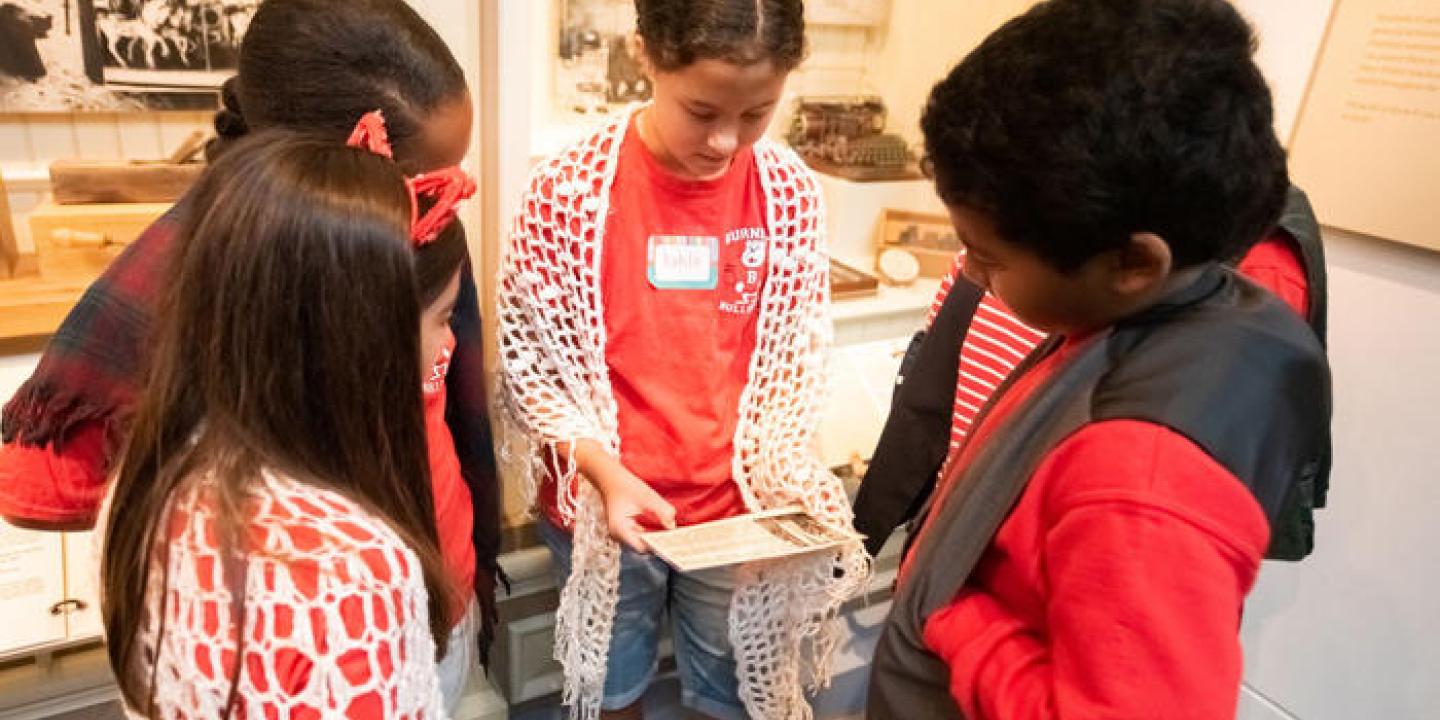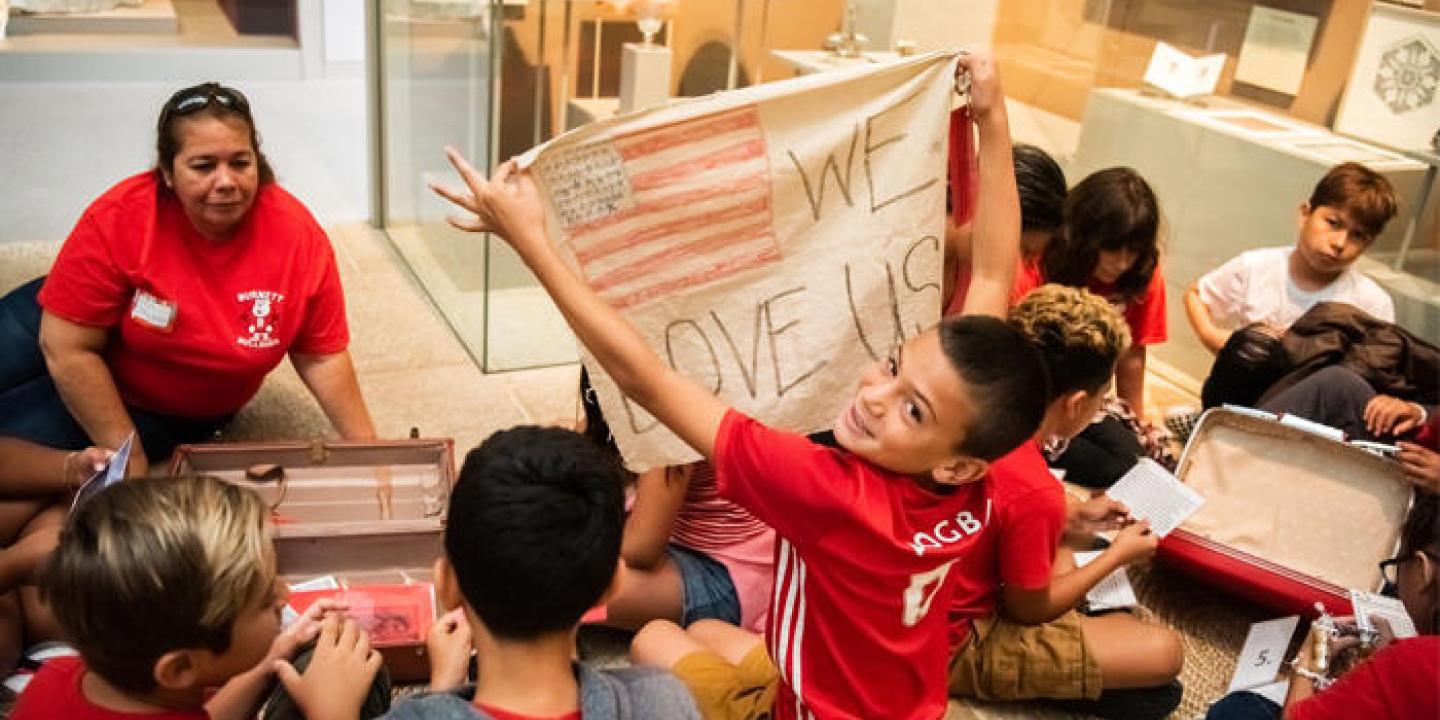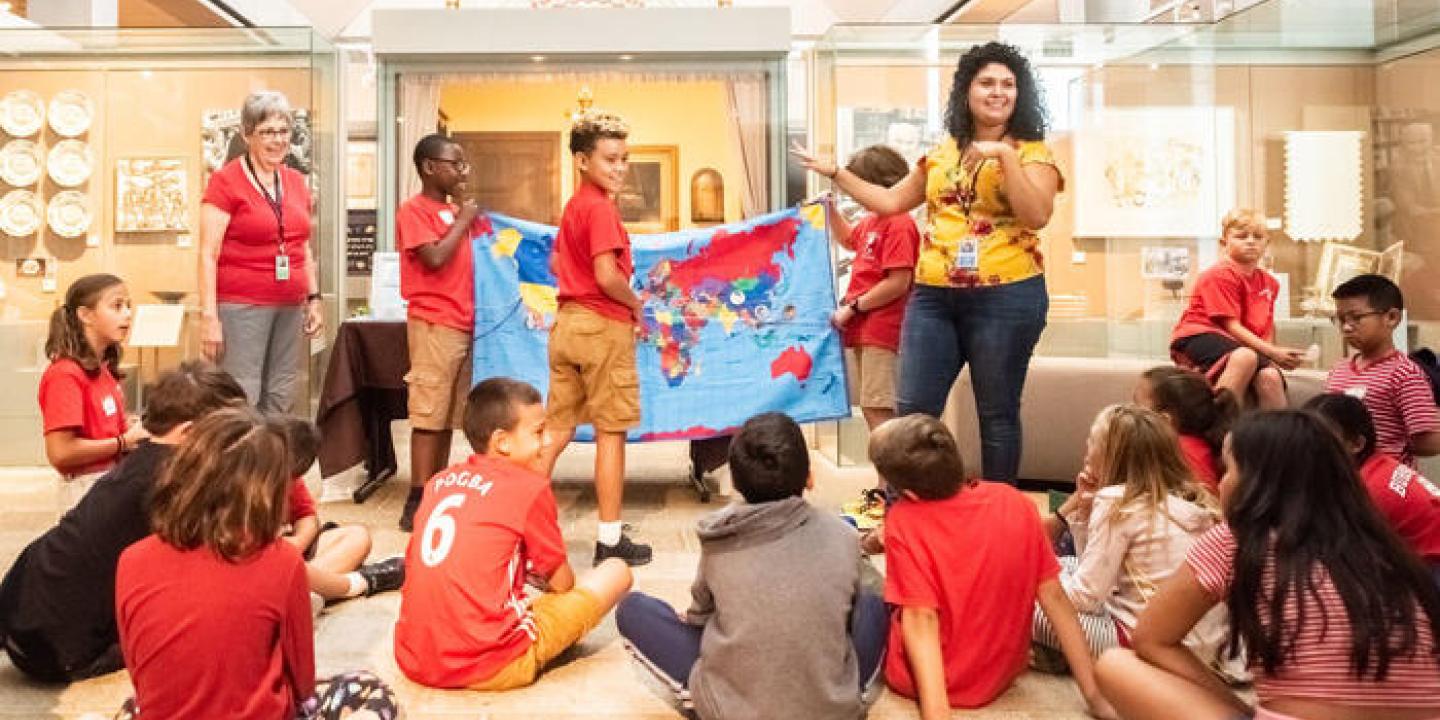The Skirball’s Grade 5 Americans and Their Family Stories school tour invites students to celebrate their commonalities and differences, build empathy, and care for their communities through storytelling. Read on to learn about one classroom’s experience and get resources on including themes of immigration, courage, and family history into your classroom curriculum.
February 2020
About one hundred years ago, as war waged on around them, Reva Nebrat and her family fled northern Ukraine and took passage to the United States. In a suitcase, they packed a few photos, Reva’s favorite doll, and Shabbat candlesticks, among other meaningful belongings. How do you think they felt as they made this voyage? What would you bring if you were moving to a new land? These are some of the questions posed to Grade 5 students during the Americans and Their Family Stories school tour—an immersive program that links our unique journeys to one another and to American lives across time.
Skirball for this Grade 5 school tour. After a warm welcome, the group convened in the core exhibition, Visions and Values: Jewish Life from Antiquity to America. Oriented right away to the topic of the day, the students were asked why some people leave their homelands in the first place. One by one they revealed a strong awareness of the circumstances, incentives, dreams, and realities that drive the movement of populations around the globe. “To get a job,” replied a student standing in the front. “Because they want to vote?” proposed a classmate nearby. Two others raised their hands eagerly. “Maybe they have a bad ruler in their own country,” suggested one of them, while the other explained, “So they can be back with their families.”
Keeping in mind the many reasons for migration worldwide, the class approached the exhibition’s replica of the Statue of Liberty torch. Here the students began to role-play a particular American immigration experience: that of European Jews arriving at New York Harbor at the turn of the twentieth century. “Let’s go back in time to 1908,” announced the lead docent on the tour, as she helped the kids get into character. Together the “passengers” boarded a ship, waved goodbye to loved ones, and endured weeks of arduous travel. Costumed in shawls and vests reminiscent of the era, the students imagined catching sight of Lady Liberty on the horizon.
As they re-enacted the process of inspection at Ellis Island, the historical moment came to life and students expanded upon what they know about US immigration. Feelings of great empathy took hold of the student-actors. Some of them played characters who were granted easy entry into America, so they identified with the thrill of freedom and opportunity. “I made it!” exclaimed one student, who was among those who could pretend to pursue new beginnings upon arrival. By contrast, other “passengers” were questioned extensively about their health, literacy, and job prospects. “It was sad to be separated from my parents,” noted one student, whose character was quarantined due to illness. Around the gallery, the students reflected upon the triumphs and tribulations that characterized many stories of Ellis Island. As they came to understand, it was an island of hope but also one of tears.

Through objects, storytelling, role play, and conversation, students consider how new Americans adapt, overcome challenges, and find opportunity in their new homeland.
As the school tour continued, Skirball educators told the stories of several first- and second-generation American Jews, such as German-born entrepreneur Levi Strauss, Polish-born labor union leader Rose Schneiderman, and Reva Nebrat and her family, who came to the US in the wake of the Russian Revolution. Turning to a suitcase prop filled with the kinds of things the Nebrats brought with them, the docent asked students what they would bring if they had to flee their homes. Not unlike Reva’s family, the students chose objects of comfort and sustenance, such as a teddy bear and fresh water. “We took more than just things though,” reminded the docent, who played the role of Reva herself. “We took our intelligence, courage in our hearts, and hope that we’d have better lives once we reached America. That is how we really survived.”

During the final portion of Americans and Their Family Stories, the class moved beyond the narrative of European Jewish immigration to explore real and composite stories of people from different times and places. They learned that Aduke was forcibly transported to America from Gambia and sold into slavery in 1830. Lee-Yao emigrated from China in 1948 during the Gold Rush, while Refugio found safe haven from the Mexican Revolution in 1912. Tuyen fled Vietnam on a boat in 1974 and was rescued on the high seas by the US Navy. Much more recently, Jose was brought from the Philippines as a child in 1993 and only much later found out he was undocumented. Each story was represented by a suitcase of its own, packed with props to illustrate aspects of the person’s particular journey. Split up into five groups, the class opened each suitcase and examined what lay therein. One group looked at the kind of map Refugio might have used to cross the border. A student tried on a “Made in America” jacket similar to the one Jose wore on the flight from Manila. A statue of Buddha in the Tuyen suitcase prompted students to consider why a religious object might be important enough to carry across the miles. “Maybe all they had left were their prayers,” they wondered.

Throughout the school tour, staff educators help students recognize the commonalities and differences between family stories across different times, geographic locations, and cultures.
As the field trip came to a close, the fifth graders gathered in a circle to share what they took away from the experience. For several of them, learning about the harrowing challenges faced by past generations taught them “to have gratitude.” Others drew inspiration from the persistence of those seeking a brighter future, saying, “Their hard work must have paid off.” From the other side of the room, a group of classmates called out a lasting lesson for everyone: “When you think you can’t do something, you should think of people who fought hard before,” they concluded, “then have the courage not to give up.”
If you’d like to include themes of immigration, courage, and family history into your classroom curriculum, check out the following resources:
- The Journey by Francesca Sanna
- Define American (a narrative and culture change organization that uses media and the power of storytelling to shift the conversation about immigrants, identity, and citizenship)
- Short films about refugees recommended by human rights educators (Amnesty International)
- Tenement Museum teacher resources
- Immigration: Stories of Yesterday and Today (Scholastic Teacher’s Activity Guide)
- Enrique’s Journey: The True Story of a Boy Determined to Reunite with His Mother by Sonia Nazario